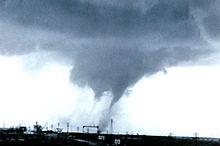Multiple vortex

A multiple-vortex tornado is a type of tornado in which two or more columns of spinning air rotate around a common center. Multivortex structure can occur in almost any circulation, but is very often observed in intense tornadoes. These vortices often create small areas of heavier damage along the main tornado path. This is a distinct phenomenon from a satellite tornado, which is a weaker tornado which forms very near a large, strong tornado contained within the same mesocyclone. The satellite tornado may appear to "orbit" the larger tornado (hence the name), giving the appearance of one, large multi-vortex tornado. However, a satellite tornado is a distinct circulation, and is much smaller than the main funnel.
Waterspout

A waterspout is defined by the National Weather Service as a tornado over water. However, researchers typically distinguish "fair weather" waterspouts from tornadic waterspouts. Fair weather waterspouts are less severe but far more common, and are similar to dust devils and landspouts. They form at the bases of cumulus congestus clouds over tropical and subtropical waters. They have relatively weak winds, smooth laminar walls, and typically travel very slowly. They occur most commonly in the Florida Keys and in the northern Adriatic Sea. In contrast, tornadic waterspouts are stronger tornadoes over water. They form over water similarly to mesocyclonic tornadoes, or are stronger tornadoes which cross over water. Since they form from severe thunderstorms and can be far more intense, faster, and longer-lived than fair weather waterspouts, they are more dangerous.
Landspout
A landspout, or dust-tube tornado, is a tornado not associated with a mesocyclone. The name stems from their characterization as a "fair weather waterspout on land". Waterspouts and landspouts share many defining characteristics, including relative weakness, short lifespan, and a small, smooth condensation funnel which often does not reach the surface. Landspouts also create a distinctively laminar cloud of dust when they make contact with the ground, due to their differing mechanics from true mesoform tornadoes. Though usually weaker than classic tornadoes, they can produce strong winds which could cause serious damage.
Similar circulations
Gustnado

A gustnado, or gust front tornado, is a small, vertical swirl associated with a gust front or downburst. Because they are not connected with a cloud base, there is some debate as to whether or not gustnadoes are tornadoes. They are formed when fast moving cold, dry outflow air from a thunderstorm is blown through a mass of stationary, warm, moist air near the outflow boundary, resulting in a "rolling" effect (often exemplified through a roll cloud). If low level wind shear is strong enough, the rotation can be turned vertically or diagonally and make contact with the ground. The result is a gustnado. They usually cause small areas of heavier rotational wind damage among areas of straight-line wind damage.
Dust devil
A dust devil resembles a tornado in that it is a vertical swirling column of air. However, they form under clear skies and are no stronger than the weakest tornadoes. They form when a strong convective updraft is formed near the ground on a hot day. If there is enough low level wind shear, the column of hot, rising air can develop a small cyclonic motion that can be seen near the ground. They are not considered tornadoes because they form during fair weather and are not associated with any clouds. However, they can, on occasion, result in major damage in arid areas.